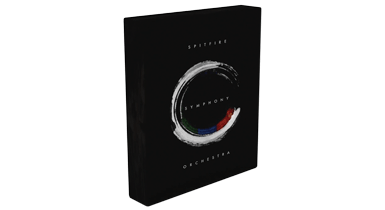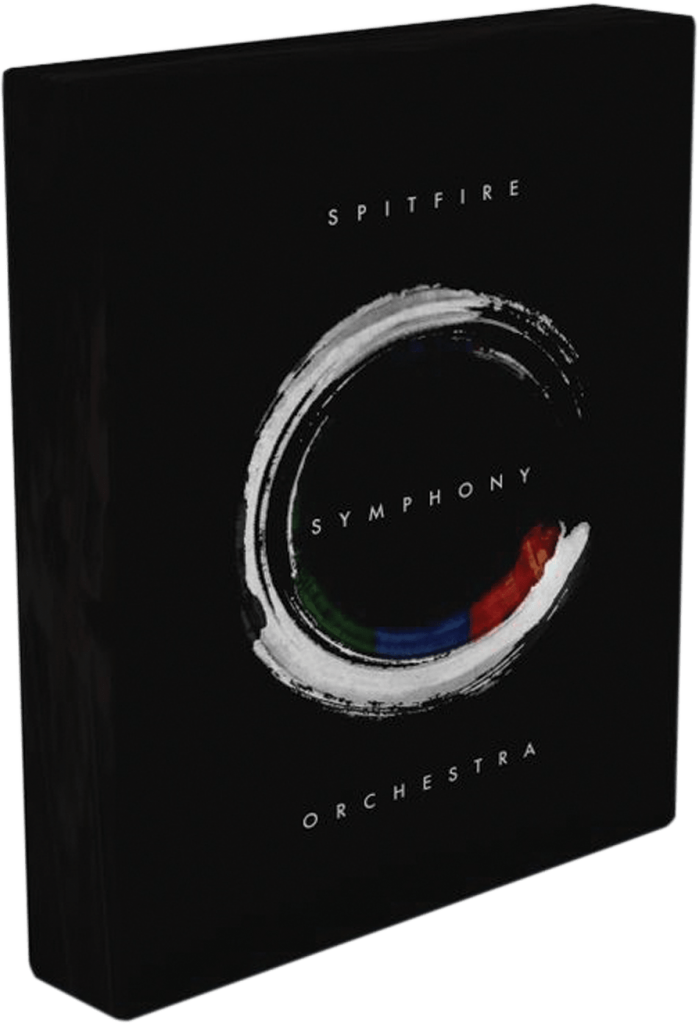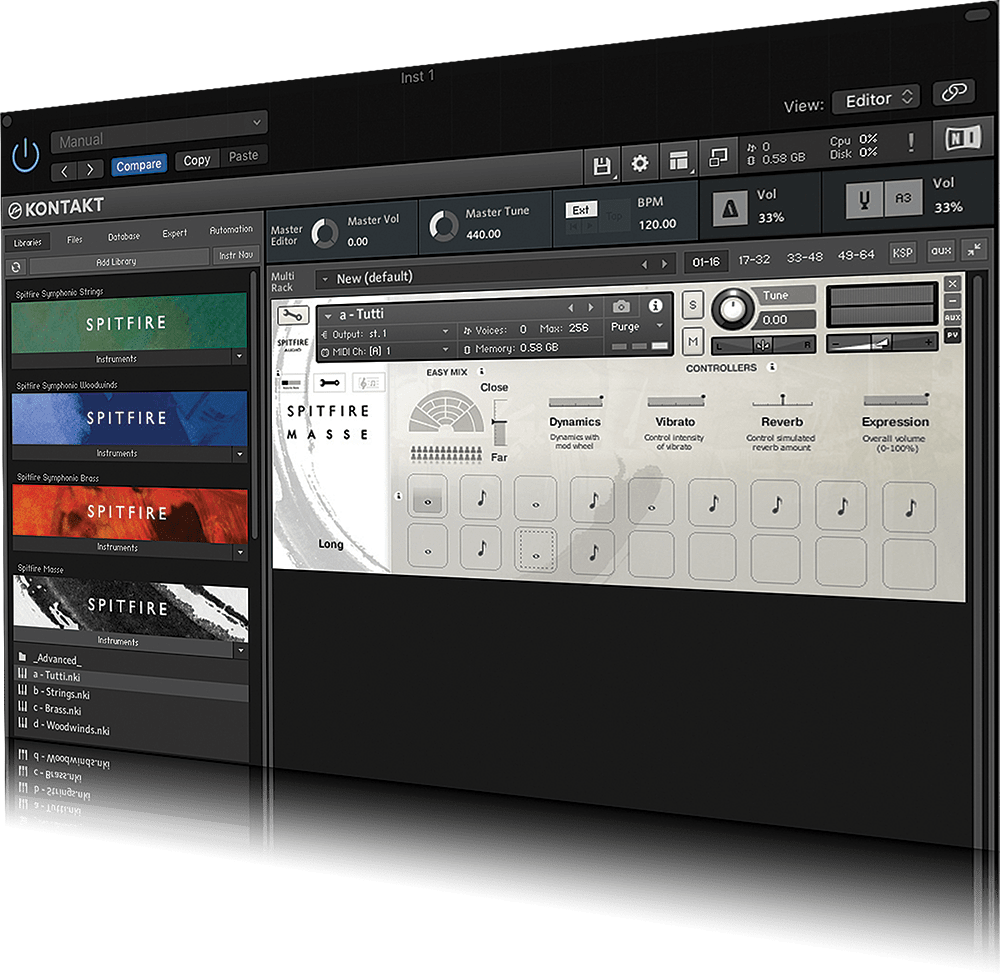Spitfire Audio Spitfire Symphony Orchestra Review
With a rousing sense of recapitulation, Dave Gale takes a look at the latest large-scale symphonic offering from Spitfire Audio… Price £1,599 + VAT Contact Spitfire Audio Spitfire Symphony Orchestra key features: Full String, Wind and Brass section orchestral library Includes a multitude of Doubling instruments Key switching available throughout Huge dynamic and performance control […]

With a rousing sense of recapitulation, Dave Gale takes a look at the latest large-scale symphonic offering from Spitfire Audio…


Price £1,599 + VAT
Contact Spitfire Audio
Spitfire Symphony Orchestra key features:
- Full String, Wind and Brass section orchestral library
- Includes a multitude of Doubling instruments
- Key switching available throughout
- Huge dynamic and performance control
- Requires Kontakt/Kontakt player
- Compatible with NI’s NKS standard
- 385.9GB of uncompressed samples
- Future mic expansion packs available shortly
Orchestral samples have come a very long way over the last 10 years or so, partly thanks to the technology that is now available, but also via the innovation that is now on offer from companies such as Spitfire Audio. But what sets Spitfire apart from others is two fold.
Firstly, the operation was set up by two media composers, who have a thorough understanding of the requirements of industry musicians, but also the model that has been established for paying the sampled players royalties, thus safeguarding future musicians’ talents for further developments in this arena.
It’s all very commendable, but what of the actual library? Well, much of this library is actually a reworking of existing Spitfire libraries – it represents Symphonic String, Wind and Brass sections, but now with an additional ‘Masse’ ensemble element, offering one-stop, large-scale patches for immediately gratifying results.
One criticism often levelled at the older-style Spitfire libraries was that it was debatably more complicated than it might be to access the samples – they’d often have to be loaded via Kontakt’s ‘file’ architecture, rather than via the more gratifying ‘Library’ architecture. Spitfire has made a conscious shift towards the latter method with its more recent library additions, most notably with its superb Albion series and Spitfire Symphony Orchestra makes a further move towards this more immediate modus operandi.
Contents, en masse
Pointing out the rather obvious, this is very much an orchestral library and is designed specifically for musicians and composers who need orchestral sounds. Unlike some other Spitfire libraries, you’ll not find any percussion here, just full sections of Strings, Wind and Brass – although some instruments offer solo patches, as one might expect from a full orchestra.
The String section construct is very much ensemble-based, and symphony orchestra-sized, offering 16 1st Violins, 14 2nd Violins, 12 Violas, 10 Cellos and eight Double Basses. The Woodwind section is also symphonic in size, but offering both ‘a2’ (two player) versions of patches alongside solo patches. There’s also a very healthy contingent of Doubling instruments, and some of them are quite obscure – with Alto Flute, Bass Flute, Bass Clarinet, Contrabass Clarinet, Contrabassoon, Cor Anglais and Piccolo.
By any standards, that’s about as comprehensive as a Woodwind section can be, and even Stravinsky would be happy with that bewildering collection, although Michael Tippett often liked a Bass Oboe, which is omitted – no real harm there!

The Brass section here is the exact-same package as the Symphonic Brass library reviewed in MT165, so we’ll not repeat ourselves unnecessarily here – however, I will just mention how truly outstanding it is, once again.
As a brass player myself, I continually find brass samples falling very short, but this is about the best I have heard to date. The ‘a2 legato trumpet’ is an absolute patch of joy, that would even put a smile on Aaron Copland’s face, were he around to hear it.
And finally, we have an entirely new offering in the shape of ‘Masse’, which is, as you can probably deduce, the instantaneous ‘en masse’ ensemble instrument. In true ‘best patch first’ style, your first entrée to Masse is called ‘Tutti’, which very much offers a full-on form, in either long or short articulations.
Not surprisingly, it’s very epic in volume and size and a perfect out-of-the-box way to get some immediate inspiration. However, a short meander though the patches which follow it reveals even more useful ensembles, particularly in the shape of Strings, Wind and Brass on their own.
Theoretically, it would be possible to bring up a patch of each, and get stuck in with a composition, but for my money, I’ve always liked bringing up an ensemble string patch to thrash out a basic compositional idea, before heading for individual instruments in a more conventional way.
However, it’s good to see both Brass and Woodwind ensembles represented here, as this fills what could be argued was a hole in some of Spitfire’s previous products, where you might have had to pay more to get an ensemble version. Just bringing up an ensemble brass patch immediately entices you to play something chorale-like; inspiring from the off, and that’s a wonderful thing.
The finer details
Turning our attentions back to the stringed elements, taking a wander through the options is bewildering but equally satisfying. As this is largely a repackaging of Mural Symphonic Strings, from a previous product incarnation, we’ve all come to expect how good this will be sonically. Sure enough, there is no disappointment – in fact, the ability to easily access just what you want, either manually or by key-switching, is elegant.
For any pro, a handful of Kontakt patches will have a palette which will cater for everything you can possibly require. There is a sense that certain patches have been amalgamated (certainly from what I could see in the Legato bowing section), and here, the legato felt just a shade lumpy, which may well have been in part to my playing.

Often these things can be straightened out with a bit of clever editing, but that aside, Spitfire has included Legacy patches, from the Mural string collection, meaning that with a couple of clicks, I was looking at the Legato patching which I was more familiar with. It’s important to stress here how difficult Legato patches are to create.
It is the Holy Grail for fast-and-epic string-sample libraries and, in my view, Spitfire has taken it as far as it can go right now, but I bet the company also has boffins working on new ways to get it even better.
The usual control is available, for total flexibility in expression, vibrato and other handy elements such as swiftness of release; but by and large, it really does sound amazingly good right out of the box, and with the new streamlined interface, it’s quicker than ever to get going.
Do I really need this?
There’s no point in buying a library like this if you’re making and producing electronic styles of music, as you will probably not need all of it. It might have its place – in fact, you might just like to use certain elements – in which case, you would be advised to look at the individual sections, rather than fork out for the whole kit and caboodle.
But if you’re a composer working in a more classical or filmic/media- based genre, this is an absolute gem of a package to consider. Its strength in so many areas makes it hard to beat, and you might find it replaces whole swathes of libraries that one might employ to add up to a sum of parts.
In my usage, it’s largely replaced much of what I used to use, with better results and with better ease of use – and this is in part thanks to the redesigned interface.
The long and short of it
And so, to the vastness of the articulations. Whatever you could possibly want, it’s here… Long notes, short notes, pizzicatos, and numerous techniques to do with the placement of the bow. It all adds up to a vast sum of parts, which is coupled with the ability to change ambience easily. Thanks to the close/far control, samples are loaded according to how ‘up close and personal’ you would like the library to sound.
It’s quick and easy and offers a swift solution without the need to visit the extensive mic’ing options that can also be made available, if required; if you’re a bit OCD, you might feel you must see exactly how things are balanced. For most, I imagine the basic stereo-mix configuration will be more than enough, as it is easy to access, economic with sample RAM and frankly, it sounds excellent.
So, with the String section receiving a large and healthy tick, it’s time to turn to the Woodwinds. These are also largely a repackage of many different libraries that Spitfire used to make available, but with the welcome addition of some new articulations. Here, a majority of the patches are ‘solo’ in nature, with the main four wind instruments also being available in two-player incarnations (a2).
It feels very similar to the Brass library previously mentioned, in the sense that there is a similar set of articulations and options, with obvious slants towards instrumental capabilities. The Legato patches are excellent, with particular praise reserved for the Alto Flute, which is completely sublime. The Oboe, in legato form, feels a shade sluggish in note production, possibly because of the nature of the way that the instrument speaks when employed in this sort of playing style.
There are no such delays perceivable in the shortened articulations, but it’s also worth mentioning that I’ve auditioned these instruments in a solo context. As we all know, there’s a certain ear-magic that occurs once there’s some context around the solo instrument, as the ear somehow makes it far more believable.
The restyling of the interface again feels very similar to the Brass, with the same options for far/close mic’ing. It’s beautiful to use, offering everything you need with a sense of immediacy – and if you need more control, then this is available through individual patches. It’s comprehensive and beautifully put together – what more could you need in a Wind library?
Instrument Line-up
There’s a very comprehensive line-up of instruments available within this package, so here’s an extended list of what’s on offer:
String Section
- 1st Violins – 16 players
- 2nd Violins – 14 players
- Violas – 12 players
- Cellos – 10 players
- Double Basses – eight players
Articulations include (main elements):
- Legato (bowed, fast, fingered, runs, etc)
- Long notes (normale, flautando, con sord, sul ponte, marcato, etc)
- Short notes (spiccato, pizzicato, con sord, brushed, harmonics, 0.5/1.0s note lengths, etc)
- Trills (major and minor 2nds/3rds)
- Tremolos and various FX
Woodwind Section
- Piccolo, Flute (solo & a2), Alto Flute, Bass Flute
- Oboe (solo & a2), Cor Anglais
- Clarinet (solo & a2), Bass Clarinet, Contrabass Clarinet
- Bassoon (solo & a2), Contrabassoon
Articulations include (vary across instruments) :-
- Long notes – normal, legato, flutter, harmonics, overblown, trills, etc
- Short notes – marcato, staccato, tenuto, sforzando, etc
Also included are FX patches and more, at a ‘per instrument’ level
Brass Section
- Trumpet (solo, a2 & a6)
- French Horn (solo, a2 & a6)
- Tenor Trombone (solo & a2)
- Bass Trombone (solo)
- Trombones (section a6)
- Tuba (solo)
- Contrabass Tuba (solo)
- Cimbasso (solo and a2)
Articulations include (vary across instruments) :-
- Long notes – normal, legato, flutter tongue, rip, falls, trills, cuivre, etc
- Short notes – staccato, marcato, tenuto, etc
Also included are muted (con sord), FX patches and more, at a ‘per instrument’ level
Re-repeat
One welcome feature to be found within all sections is the ‘Ostinatum’ element – which amounts to Spitfire’s answer to some form of onboard sequencer. The concept here is to allow the user to enter note/rhythm information in step time, and then have it play back, at the press of a note.
I’m not sure that many professionals will find themselves drawn to this, as you could arguably just play back the notes manually into your DAW. But certainly there is an appeal to the feature if you’re going to find yourself repeating notes, especially if they’re in quick succession. Think Mars, The Bringer Of War from The Planets, and you could happily program up the 5/4 rhythm to play automatically… and with triplets in fast succession, you can sort of see the appeal, for some.
Conclusion, in breadth
I have to confess that I largely knew what to expect when taking on this library to review, mainly because I have been a user of many of the Spitfire libraries that have predated Spitfire Symphony Orchestra. I truly believe that Spitfire, along with a very small handful of other library companies, has led the charge for improving the quality of orchestral samples, but unlike some libraries that you’ll hear from across the pond, there is a certain ‘British’, even European, sonority which is slightly more modest, and this is a very good thing indeed.
British string sections are the envy of the world, and it’s partly down to the school of playing that we have in this country. Sonically, for whatever reason, to my ears, it’s not as harsh or bright as elsewhere in the world and you’ll just want to employ that silkiness wherever you can.
The sheer volume of articulation options, coupled with the immense control of tone, is excellent. Depending on the line you play, you might still have the odd moment where the Legato phrasing requires some help, but with some clever programming, possibly with smoke and mirrors, you would be hard pushed to know that you hadn’t visited Air Studios, which is of course exactly where this library was recorded.
You could say the same of the Wind and Brass. There’s a similar sonority to these too, particularly in the Brass where there is no abrasiveness – at least unless you want there to be, in which case, Symphonic’s Brass can rip with the best of the them.
The Winds offer such an extensive selection of instruments that this really could be the one-stop-shop for all your woodwind needs. If I’m truly honest, I found the vibrato control to be a little bit ‘on’ or ‘off’ with some patches, notably the Solo Oboe, but the classiness of its woodwind colleagues almost makes up for it. In a soloistic sense, I’ve always preferred the lower pitched Cor Anglais, which seems to be mellower and less harsh in use.
So, when you take all elements into account, and throw in the new ‘Masse’ instrument, this really is an excellent collection for all your non-percussive orchestral needs. All of the elements are available as separate items, but with the appeal of a 35 per cent saving overall, if purchased within the full bundle, this really does represent excellent value.
Yes, it’s a lot of money. But all orchestral libraries are expensive to produce, and as I’ve found out to my own cost, you get what you pay for – and what you’re paying for here is one of the best that you can currently buy.
Alternatives
There are a number of companies across the pond, such as EastWest and Cinesamples, who have some excellent orchestral packages available, but I find they can be quite bright and they won’t be to the taste of everyone.
So, for my money, the closest competitor to Spitfire – in terms of sonority, attention to detail and sheer class – is Germany’s Orchestral Tools, which offers its own Berlin orchestral series. OT has a very similar outlook and model to Spitfire, and in truth, it comes down to whether you want to drive an Aston Martin or a Porsche (neither of which I drive myself, I hasten to add)!
They both have an astonishing number of strengths, in all departments, with similarly well-recorded and produced sample libraries. However, the OT packages are slightly more fragmented, which you could argue gives you more control over what you need. I like the bundle idea that Spitfire offers here, even though it’s lacking orchestral percussion.